Are you curious about the differences between CNC cutting and milling?
These two computer-controlled machining processes may seem similar, but they actually have distinct characteristics that make them suitable for different applications.
In this article, we will explore the disparities between CNC cutting and milling, including the materials they can handle, their precision capabilities, and their overall design.
By the end, you’ll have a clear understanding of which method is best suited for your project.
Key Takeaways:
- CNC cutting and milling are computer-controlled machining processes used for subtractive manufacturing.
- CNC routers are ideal for cutting softer materials and rapid reproduction, while CNC mills excel at machining hard materials and achieving high precision.
- Choosing the right method depends on factors like material type, desired accuracy, and design complexity.
- CNC routers and mills share similarities, such as being computer-controlled and using cutting tools to shape the workpiece.
- Both CNC cutting and milling play vital roles in various manufacturing projects.
What Is a CNC Router?
A CNC router is a specialized machine designed for cutting softer materials such as plastic, foam, and wood. It is a computer-controlled tool that uses rotational speed to drive the cutting tool, resulting in faster machining. CNC routers are commonly used in industries such as woodworking, sign-making, and prototyping.
Unlike CNC mills, which are capable of handling tough materials like steel and aluminum, CNC routers excel in working with soft materials. They are ideal for rapid reproduction and can handle large work surfaces, making them suitable for projects that require quick turnaround times.
| Advantages of CNC Routers: | Disadvantages of CNC Routers: |
|---|---|
|
|
While CNC routers offer speed and versatility, they are less accurate than CNC mills. This makes them better suited for projects that do not require high precision levels. If your project involves cutting soft materials and you prioritize rapid reproduction over extreme precision, a CNC router may be the right choice for you.
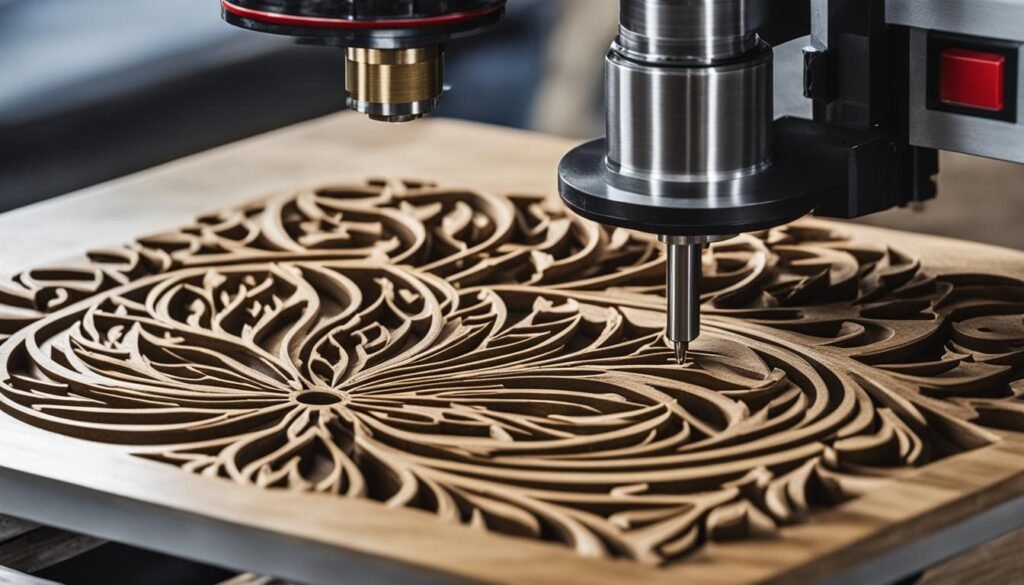
What Is a CNC Mill?
A CNC mill is a powerful machine specifically designed for heavy-duty jobs and the machining of hard materials such as steel, aluminum, and titanium. Unlike a CNC router, which is primarily used for softer materials like wood and plastic, a CNC mill is built to handle the toughest materials with precision and accuracy.
The key advantage of a CNC mill lies in its ability to generate superior torque, allowing it to tackle the demanding task of machining hard materials. This torque enables the mill to remove material with ease and achieve tight tolerances within one 1,000th of an inch. With its robust construction and stability, a CNC mill is able to produce intricate designs and create detailed parts that require high precision levels.
| Advantages of CNC Milling | Disadvantages of CNC Milling |
|---|---|
| – Ability to handle hard materials | – Smaller cutting area |
| – High precision and accuracy | – Slower machining speed |
| – Ideal for creating detailed parts | – Higher cost compared to CNC routers |
With its superior power and precision, a CNC mill is the go-to choice for industries such as aerospace, automotive, and manufacturing, where the production of complex and precise components is crucial. Whether it’s crafting intricate molds, machining metal parts with intricate details, or creating prototypes, a CNC mill delivers exceptional results.
So, if you’re looking to work with hard materials and require utmost precision and accuracy for your projects, a CNC mill is the perfect tool to bring your designs to life.
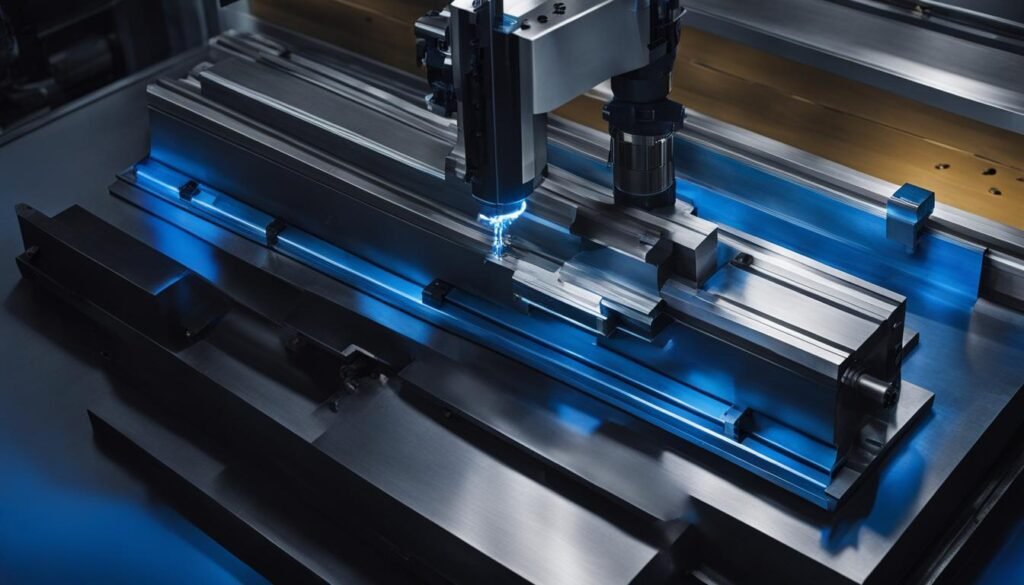
CNC Router vs. CNC Mill — What’s the Difference?
When it comes to CNC machining, two popular methods are CNC routers and CNC mills. While both machines share some similarities, there are key differences that make each method better suited for certain applications. Let’s take a closer look at the differences between CNC routers and CNC mills, so you can determine which one is the right choice for your project.
CNC Router: Ideal for Cutting Softer Materials
A CNC router is specifically designed to cut softer materials such as plastic, foam, and wood. It is perfect for projects that require rapid reproduction and can handle large work surfaces. However, CNC routers are less accurate compared to CNC mills. They use rotational speed to drive the cutting tool, resulting in faster machining but less torque. If your project does not require high levels of precision, a CNC router is a cost-effective option.
CNC Mill: Precision and Stability for Hard Materials
A CNC mill is the go-to machine for heavy-duty jobs and can handle tough materials like steel, aluminum, and titanium. It offers more accuracy and stability compared to a CNC router. With precision capabilities within one 1,000th of an inch, CNC mills are ideal for creating detailed pieces and parts that require tight tolerances. They may have a smaller cutting area compared to routers, but they provide exceptional accuracy and stability.
The main differences between CNC routers and CNC mills lie in the materials they can handle and their machining speeds. Routers are best suited for cutting softer materials and rapid reproduction, while mills excel at machining hard materials and achieving high precision levels. Routers prioritize speed, while mills prioritize accuracy. Consider the materials you’re working with, the desired accuracy, and the complexity of the design to choose the right method for your project.
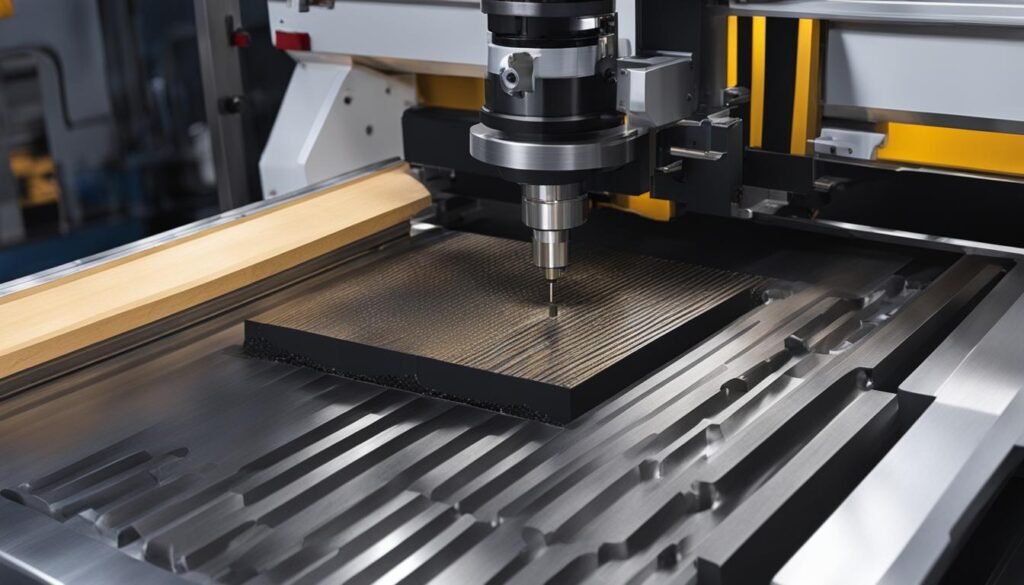
| CNC Router | CNC Mill |
|---|---|
| Best for cutting softer materials | Best for machining hard materials |
| Uses rotational speed for fast machining | Offers precision within one 1,000th of an inch |
| Less accurate compared to CNC mills | Provides exceptional accuracy and stability |
| Ideal for rapid reproduction | Creates detailed pieces with tight tolerances |
Similarities Between CNC Routers and CNC Mills
While CNC routers and CNC mills have their differences in terms of materials and machining speeds, they also share several similarities. Both machines are computer-controlled and utilize computer-aided design (CAD) or computer-aided manufacturing (CAM) programs to execute their cutting operations. Whether it’s a CNC router or a CNC mill, the process begins with a digital design that is translated into precise instructions for the machine to follow.
One of the key similarities lies in the use of cutting tools. Both CNC routers and mills employ cutting tools, such as end mills or router bits, to remove material from the workpiece. These tools are carefully selected based on the specific requirements of the project, such as the desired cutting speed, the type of material being worked on, and the intricacy of the design.
Additionally, both CNC routers and mills operate by subtractive manufacturing, wherein material is removed from the workpiece to achieve the desired shape. This approach allows for precise control over the final product, enabling manufacturers to create intricate and complex designs with ease.
Effective Use of CNC Routers and Mills
While CNC routers are best suited for cutting softer materials like plastic, foam, and wood, CNC mills excel in machining hard materials such as steel, aluminum, and titanium. Routers are often used in applications that require high production speed and rapid reproduction, making them ideal for larger-scale projects. On the other hand, mills are the preferred choice for projects that demand high precision and intricate detailing.
By understanding the similarities and differences between CNC routers and mills, manufacturers can make informed decisions on which method to employ for their specific needs. Whether you opt for a router or a mill, both machines offer advanced capabilities that can enhance the efficiency and accuracy of your manufacturing processes.
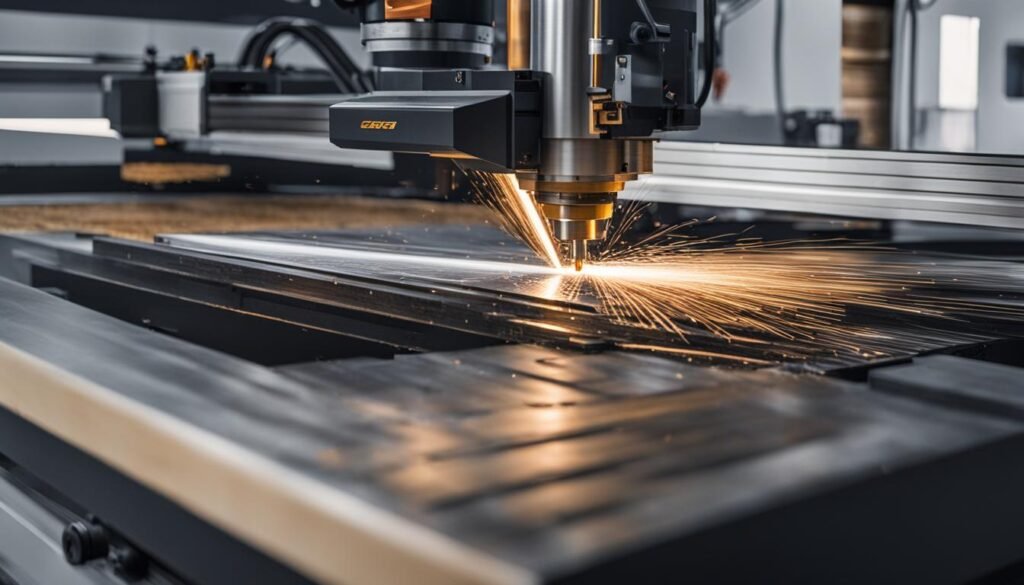
Table: A Comparison of CNC Routers and CNC Mills
| Features | CNC Router | CNC Mill |
|---|---|---|
| Materials | Soft materials such as plastic, foam, and wood | Hard materials such as steel, aluminum, and titanium |
| Cutting Speed | Fast | Slower than routers |
| Precision | Less accurate | High precision, within 1/1000th of an inch |
| Applications | Rapid reproduction, large work surfaces | Detailed pieces, tight tolerances |
CNC Router Workspace and Tools
When it comes to CNC routers, the workspace is an important aspect to consider. These machines are designed to handle larger sizes of softer materials such as wood or plastic. The workspace of a CNC router is often wide enough to accommodate these larger pieces, allowing for more flexibility in the size of projects that can be undertaken.
In terms of tools, CNC routers use router bits as the cutting tools. These router bits come in various shapes and sizes, allowing for different types of cuts to be achieved. It’s important to monitor the quality and sharpness of the router bits, as they can impact the final result. Dull or poor-quality bits can lead to less precise cuts and potentially ruin the project.
Types of Router Bits:
- Straight Bits: These bits are used for straight cuts, grooving, and dadoes.
- Flush Trim Bits: Ideal for trimming the edges of one material to match the contour of another.
- Rabbeting Bits: Used for creating rabbets, which are recessed areas in the edge or face of the material.
- Round Over Bits: These bits create rounded edges on the material.
- Chamfer Bits: Designed to create beveled edges.
“The workspace of a CNC router is a key factor in determining the size of projects it can handle. Additionally, the selection and quality of router bits play a crucial role in achieving precise and clean cuts.”
Proper maintenance of the router bits, including regular sharpening or replacement, is essential to ensure optimal performance. It’s also important to follow safety guidelines when operating a CNC router, such as wearing appropriate protective gear and being mindful of the machine’s movement and cutting speed.
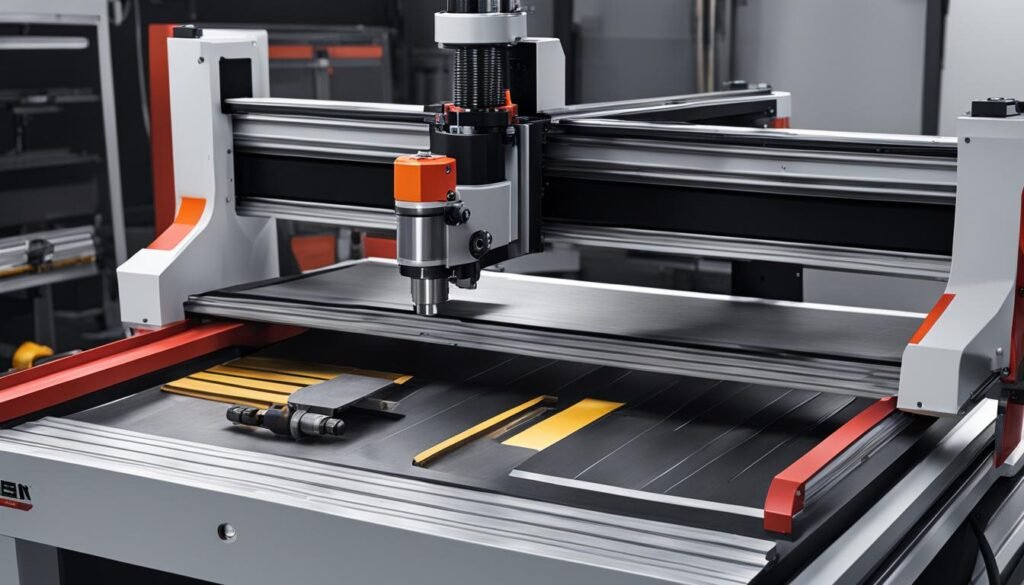
Table: Common Router Bit Shapes and Uses
| Bit Shape | Common Uses |
|---|---|
| Straight | Straight cuts, grooving, dadoes |
| Flush Trim | Trimming edges to match contours |
| Rabbeting | Creating recessed areas (rabbets) |
| Round Over | Creating rounded edges |
| Chamfer | Creating beveled edges |
CNC Milling Process and Axes
The CNC milling process is a versatile and precise method of machining, commonly used in various industries to create complex parts and components. It involves using cutting tools to remove material from a stationary workpiece, resulting in the desired shape and dimensions. The process is highly automated and controlled by computer programs, ensuring accuracy and repeatability. To understand how CNC milling works, it is essential to explore the different axes involved in the process.
The most common configuration in CNC milling is the 3-axis setup, which allows movement along the X, Y, and Z axes. The X-axis represents horizontal movement from left to right, the Y-axis represents vertical movement from front to back, and the Z-axis represents vertical movement from top to bottom. By combining these three axes, CNC milling machines can achieve precise and intricate cuts, creating complex geometries.
In addition to the three primary axes, some CNC mills have additional axes, such as the A-axis and the B-axis. The A-axis enables rotation around the X-axis, allowing for more flexibility in machining. The B-axis enables rotation around the Y-axis, further enhancing the machine’s capabilities. These additional axes are particularly valuable for creating features with curved surfaces or for performing operations that require multiple orientations.
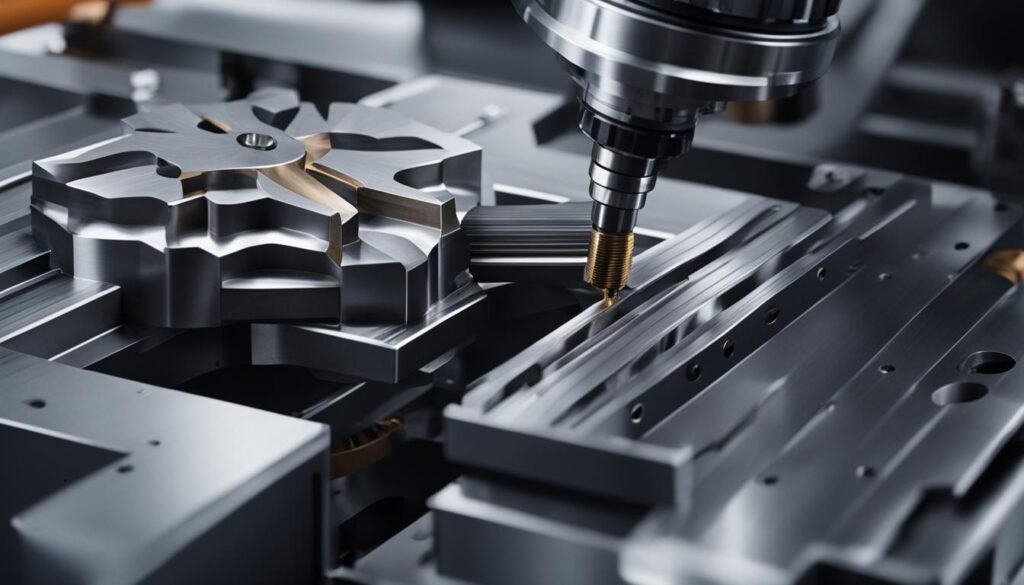
Table: Comparison of CNC Milling Axes
| Axis | Movement | Functionality |
|---|---|---|
| X-axis | Horizontal | Moves the cutting tool along the workpiece’s horizontal plane. |
| Y-axis | Vertical | Moves the cutting tool vertically, from front to back. |
| Z-axis | Vertical | Moves the cutting tool vertically, from top to bottom. |
| A-axis | Rotational | Enables rotation around the X-axis for increased machining flexibility. |
| B-axis | Rotational | Enables rotation around the Y-axis, expanding the machine’s capabilities. |
With the precision and versatility provided by CNC milling machines and their multi-axis configurations, complex and intricate parts can be manufactured with ease. The ability to control the movement of the cutting tool along various axes allows for the creation of highly detailed geometries and intricate designs. Whether it’s producing prototypes, small batches, or large-scale productions, CNC milling offers a reliable and efficient method for achieving precise results.
CNC Turning vs. CNC Milling
When it comes to machining processes, two common methods that often come up are CNC turning and CNC milling. While both processes are used to shape and cut materials, there are some key differences between them that are important to understand. Let’s take a closer look at CNC turning and CNC milling to see how they differ.
What is CNC Turning?
CNC turning involves rotating the part while the cutting tools remain stationary. This process is often used to create cylindrical or conical surfaces. It is commonly used in the production of components such as shafts, pins, and bushings. CNC turning is known for its high precision and ability to create symmetrical parts with tight tolerances.
What is CNC Milling?
On the other hand, CNC milling keeps the material stationary while the cutting tools rotate around it. This allows for the creation of flat surfaces, pockets, grooves, and intricate designs. CNC milling is often used for more complex parts that require precise and detailed machining.
Differences between CNC Turning and CNC Milling
The main difference between CNC turning and CNC milling lies in the movement of the part and the tools. CNC turning rotates the part while the tools remain stationary, while CNC milling keeps the material stationary and rotates the tools around it. This difference in movement allows for different machining capabilities and makes each process suitable for specific applications.
| CNC Turning | CNC Milling |
|---|---|
| Rotates the part | Keeps the material stationary |
| Creates cylindrical or conical surfaces | Creates flat surfaces, pockets, grooves, and intricate designs |
| High precision and tight tolerances | Precise and detailed machining |
Now that you have a better understanding of CNC turning and CNC milling, you can make informed decisions about which method is best suited for your projects. Consider the shape and complexity of your parts, as well as the level of precision required. Both processes have their strengths and can help you achieve your desired results.
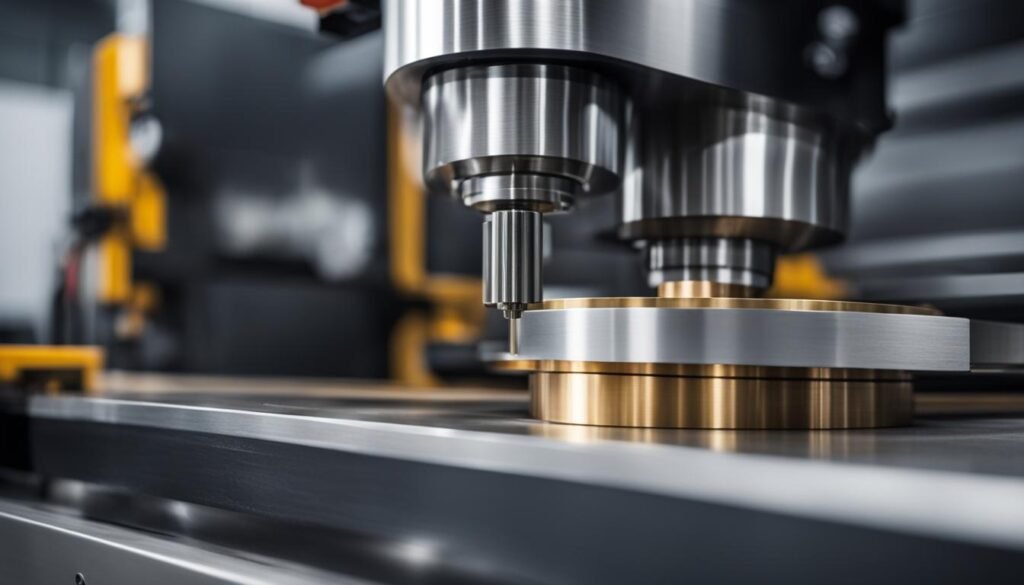
CNC Turning Process
In the world of machining, CNC turning is a fundamental process that involves using a lathe to shape and create cylindrical components. The lathe holds the workpiece in place and rotates it while cutting tools shave away excess material to form the desired shape. CNC turning is widely used in various industries, including automotive, aerospace, and manufacturing, due to its efficiency and versatility.
To understand the CNC turning process better, let’s break it down into key steps:
- Workpiece Setup: The process begins with securing the workpiece in the lathe’s chuck. The chuck firmly holds the material in place while allowing it to rotate.
- Tool Selection: Next, the appropriate cutting tools are selected based on the desired shape and material properties. These tools come in various shapes and sizes to accommodate different turning operations.
- Tool Path Programming: Once the tools are chosen, a CNC program is created to define the tool’s path and cutting parameters. This program guides the lathe’s movement and ensures precise machining.
- Turning Operation: With the workpiece secured and the program set, the lathe initiates the turning operation. The cutting tools move along the workpiece’s surface, removing material and shaping it according to the programmed design.
The CNC turning process offers several advantages, including high precision, repeatability, and the ability to create complex geometries. It is commonly used to produce components such as shafts, pins, and threaded parts. With advanced CNC technology, turning operations can be automated, increasing productivity and reducing human error.
Overall, CNC turning is an essential machining process that plays a crucial role in various industries. By leveraging the capabilities of CNC lathes, manufacturers can produce high-quality components efficiently and accurately.
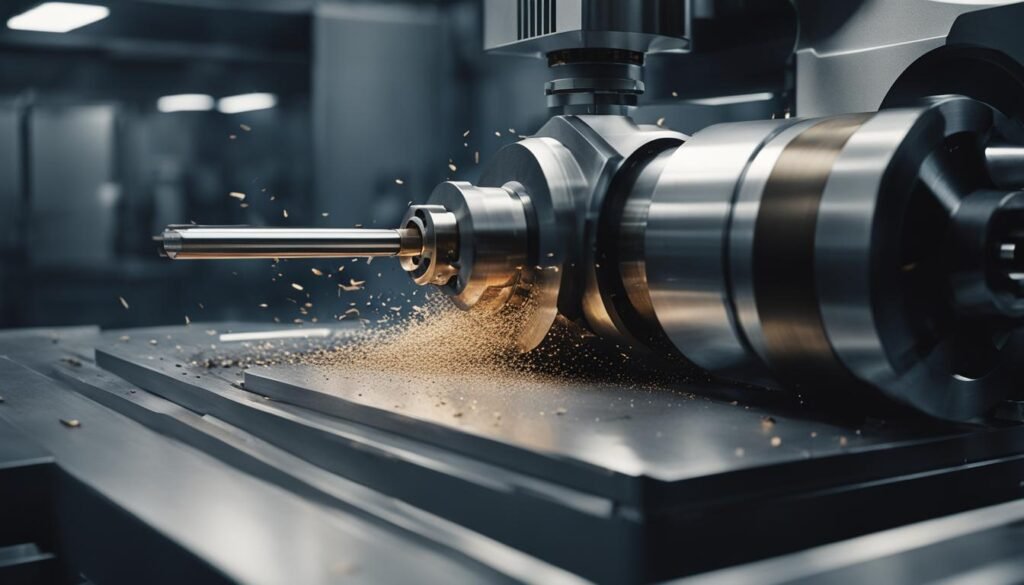
Advantages of CNC Turning
When compared to traditional manual turning methods, CNC turning offers several distinct advantages:
- Improved Precision: CNC lathes can achieve high levels of precision, resulting in consistent and accurate parts.
- Reduced Cycle Times: The automation of the turning process allows for faster production, leading to shorter cycle times and increased productivity.
- Enhanced Efficiency: CNC turning eliminates the need for manual intervention, reducing the chances of errors and increasing overall efficiency.
- Flexibility: CNC lathes can accommodate a wide range of materials, including metals, plastics, and composites, making them suitable for diverse applications.
- Cost-Effective: While CNC machines may have higher upfront costs, they can save money in the long run due to reduced material waste, improved efficiency, and increased productivity.
In conclusion, CNC turning is a vital process in modern manufacturing, offering numerous benefits in terms of precision, efficiency, and cost-effectiveness. By harnessing the power of CNC lathes, manufacturers can achieve consistent and high-quality results while maximizing productivity.
CNC Milling Process
The CNC milling process involves using various axes to move the cutting tools around the stationary material. This process allows for the creation of flat surfaces, pockets, grooves, and intricate designs. CNC mills are versatile machines that offer a wide range of cutting methods, making them suitable for both simple and complex components. The most common configuration is the 3-axis setup, but CNC mills can also have four or more axes for added flexibility.
With CNC milling, the material is held in place while the cutting tools rotate around it. The movement along the X, Y, and Z axes allows for precise control and the ability to create three-dimensional shapes. Mills can also have additional axes for more control and clearance along the Z-axis, allowing for thicker cuts.
The cutting tool used in CNC milling is called an end mill. It comes in various shapes and configurations to achieve different types of cuts. The choice of end mill depends on factors such as the material being machined, the desired surface finish, and the complexity of the design. It is important to select the appropriate end mill for each specific application to ensure the best results.
| Advantages of CNC Milling | Disadvantages of CNC Milling |
|---|---|
| Ability to create complex shapes and designs | Requires more advanced programming skills |
| High precision and accuracy | Slower machining speed compared to other methods |
| Capability to machine a wide range of materials | Higher cost of machinery and tooling |
| Flexibility to make changes and modifications during the machining process | Requires a skilled operator for setup and operation |
CNC milling is a versatile and precise machining process that is widely used in various industries, including aerospace, automotive, and manufacturing. Its ability to create intricate designs, high accuracy, and compatibility with a wide range of materials make it a preferred choice for many applications.

Conclusion
After exploring the differences between CNC cutting and milling, it is clear that both methods have their unique advantages and applications. CNC routers are ideal for cutting softer materials and achieving rapid reproduction, making them suitable for projects that prioritize speed and efficiency. On the other hand, CNC mills excel at machining hard materials with high precision, making them the preferred choice for intricate designs and tight tolerances.
When deciding between CNC cutting and milling, consider the materials you are working with. If you need to work with softer materials like plastic or wood, a CNC router will be the best choice. However, if you’re dealing with tougher materials like steel or aluminum, a CNC mill will provide the necessary power and precision.
Additionally, consider the level of accuracy required for your project. If you need precise and intricate cuts, a CNC mill is the way to go. But if speed and rapid reproduction are more important, a CNC router will be the better option.
In conclusion, understanding the differences between CNC cutting and milling allows you to make informed decisions and choose the method that best suits your project’s specific requirements. Whether you opt for the versatility of a CNC router or the precision of a CNC mill, both methods offer efficient and reliable solutions for your manufacturing projects.
FAQ
What is the difference between CNC cutting and milling?
CNC cutting and milling are both computer-controlled machines used for subtractive manufacturing. While they have similar functions, they differ in terms of the materials they can handle, power and precision capabilities, and overall design.
What is a CNC router?
A CNC router is a machine specifically designed to cut softer materials such as plastic, foam, and wood. It uses rotational speed to drive the cutting tool and is ideal for rapid reproduction and large work surfaces.
What is a CNC mill?
A CNC mill is a machine used for heavy-duty jobs and can handle tough materials like steel, aluminum, and titanium. It uses more torque than a router and can achieve precision within one 1,000th of an inch. CNC mills are ideal for creating detailed pieces and parts with tight tolerances.
What are the main differences between a CNC router and a CNC mill?
The main differences lie in the materials they can handle and their machining speeds. CNC routers are best suited for cutting softer materials and rapid reproduction, while CNC mills excel at machining hard materials and achieving high precision levels.
What are the similarities between CNC routers and CNC mills?
Both machines are computer-controlled and use cutting tools to make cuts into the workpiece. They both work via subtractive manufacturing by removing material from the piece to create the desired shape.
What is the workspace and tool configuration of a CNC router?
The workspace of a CNC router is often wide enough to accommodate large sizes of softer materials. They typically have at least three axes and use router bits as cutting tools.
What is the process and axis configuration of CNC milling?
CNC milling involves using various axes to move the cutting tools around the stationary material. The most common configuration is the 3-axis setup, with additional axes for added flexibility.
What is the difference between CNC turning and CNC milling?
CNC turning rotates the part while the tools remain stationary, while CNC milling keeps the material stationary and rotates the tools around it. Turning is ideal for creating cylindrical or conical surfaces, while milling is suitable for machining flat surfaces, creating pockets and grooves, and drilling deep holes.
What is the process of CNC turning?
CNC turning involves rotating the workpiece while the tools shave away excess material to create the desired shape. It is commonly used to create cylindrical parts and can be a cost-effective method for manufacturing these components.
What is the process of CNC milling?
CNC milling involves using various axes to move the cutting tools around the stationary material. It is ideal for creating flat surfaces, pockets, grooves, and intricate designs, offering a wide range of cutting methods for simple and complex components.
